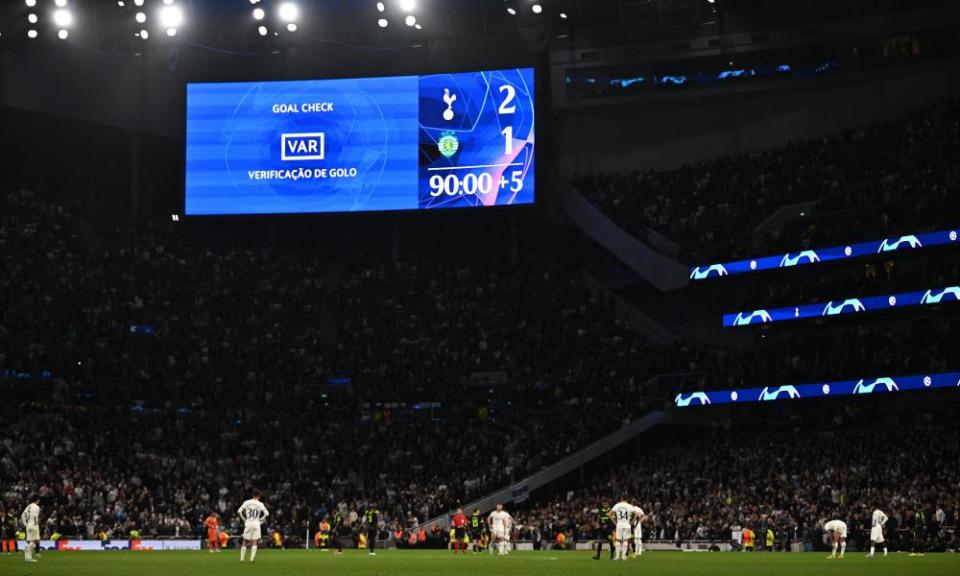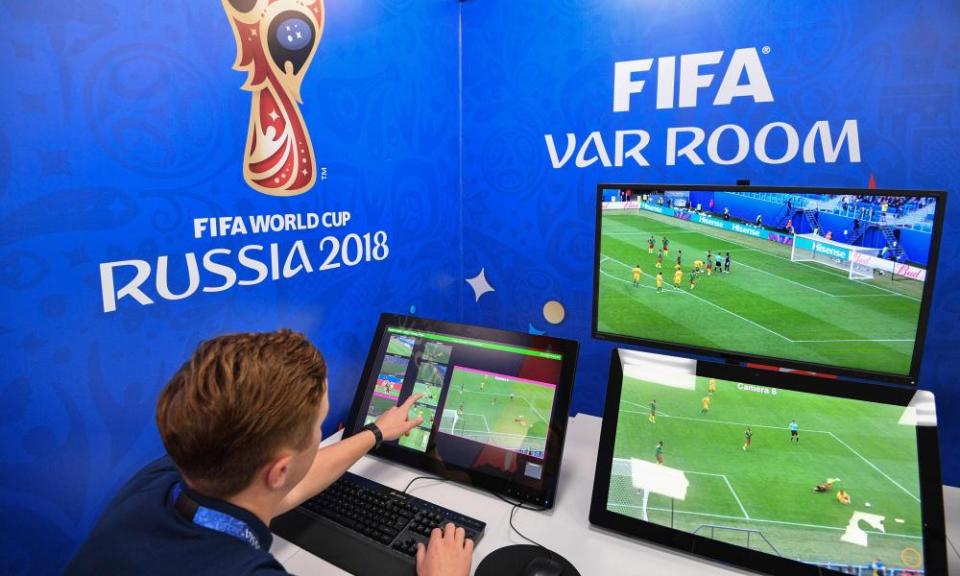SAOT ain’t slow: how does the World Cup’s AI-assisted offside system work?

What is SAOT?
It may have an acronym akin to a reality show, but Semi-Automated Offside Technology or SAOT, was designed to quell drama rather than cause it. An extension to VAR, SAOT was introduced to help reduce problems with one of the most contentious aspects of video-assisted refereeing: how to decide if a player is offside in the buildup to a goal. It will be in use at the World Cup in Qatar.
How does it work?
In a nutshell: artificial intelligence crunches location data to map the positions of players when a ball is kicked. If the AI adjudges that a player is offside, an alert is sent to the VAR showing the “kick point” of the ball and the line of offside. After manually checking that alert, the VAR official informs the referee and any on-field decision is amended accordingly.
An SAOT decision at the World Cup will be made using data sent from a sensor inside the ball, the Adidas Al Rihla, transmitting its location 500 times a second, alongside that of 12 tracking cameras around the stadium that follow both the ball and 29 different points on a player’s body (the cameras relay their information 50 times a second). The AI will also create a 3D graphic showing the line of offside and the position of players relative to it. That graphic will be generated after the decision is taken and shown to fans inside the stadium and on TV.
This is a World Cup like no other. For the last 12 years the Guardian has been reporting on the issues surrounding Qatar 2022, from corruption and human rights abuses to the treatment of migrant workers and discriminatory laws. The best of our journalism is gathered on our dedicated Qatar: Beyond the Football home page for those who want to go deeper into the issues beyond the pitch.
Guardian reporting goes far beyond what happens on the pitch. Support our investigative journalism today.
Why has it been introduced?
Law 11 of the football rulebook starts out clearly enough: a player is offside, it says, if “any part of the head, body or feet is nearer to the opponents’ goal line than both the ball and the second-last opponent”. But there are qualifications that must be applied to that rule. For example: a player can only be offside in the opponent’s half of the field, and cannot be offside if an opponent had deliberately touched the ball last. These qualifications are subject to further revisions, too. This season, the rule-making body, Ifab, was forced to clarify what “deliberate” meant, an explanation that ran to 400 words.
Given its complexity it is not surprising the offside law has provided the greatest challenges for VAR. The basic setup has an official remotely assessing an incident by replaying video footage. Such limitations did not take long to manifest themselves after VAR’s introduction to the Premier League. Video footage often cannot capture the precise moment a ball is kicked, while offside lines were also determined manually. In the case of a high-stakes decision, where the difference between a goal or not is a matter of millimetres, such an approach instantly created the possibility for frustration. Perhaps more crucially, these decisions could take several minutes to be made.
SAOT came with the promise that it would be both more precise and quicker, cutting decision times from an average of 70 seconds to 25. Fifa’s head of refereeing, Pierluigi Collina, described SAOT as “faster and more accurate” and “offering better communication to fans”.

Where has it been tested?
SAOT made its debut at the Arab Cup in Qatar last year. It has also been taken up by Uefa for this season’s Champions League.
Has it passed the test?
While there is little controversy over the accuracy of decisions under SAOT, calls that judge a player offside by margins not visible in the stadium, or on the video screen, remain controversial with managers and supporters. The main issue with SAOT, however, remains the reason it was brought in in the first place: timing.
The Arab Cup passed smoothly, but examples unearthed by the ESPN journalist Dale Johnson found delays of well over a minute and, in one instance, over two minutes in making calls on goals with potential offside incidents. This pattern has spilled over into the Champions League this season. Harry Kane had a winning goal ruled out against Sporting Lisbon because of the interpretation of a subclause of the offside law that took four minutes to make. There was also a lengthy delay in Liverpool v Napoli and controversy following an overturned Patrik Schick goal for Bayer Leverkusen against Club Brugge.
In the Kane example, it is hard not to imagine that the delay was generated not so much by the technology than by the subsequent intervention of human beings whose job it was to apply the offside law in full. Human fallibility and/or subjectivity, alongside the complexity of rules that have been written by humans (handball being not far behind offside in this regard), remain the biggest hurdle to VAR working efficiently. Uefa notes, however, that offside decisions are taking on average 30 seconds less to complete in the Champions League than in this season’s Europa League, where basic VAR is still in operation.
In previous Fifa tournaments, namely the men’s World Cup of 2018 and the women’s of 2019, VAR managed to avoid taking centre stage, perhaps due to greater discretion being allowed to the officials on the pitch – something a lot of fans would like to see more consistently. If that is the case again in Qatar, the hope might yet be for the upside of correct decisions without the pain of soul-sapping delays.
